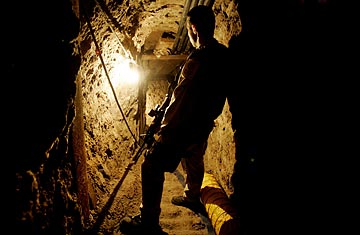
Enforcement
Though the authorities have many sophisticated tools at their disposal — by 2014, it is projected that most of the border aboveground will be monitored by sensor-equipped towers — most tunnels are uncovered through human intelligence. There is, as yet, no easy way to detect the tunnels below ground.
(2 of 2)
Tunnels have been a factor in conflicts and escapes for millennia; only after the Vietnam War did the world came to appreciate the engineering marvel the Vietnamese Communists accomplished in the Cu Chi tunnel networks, which was as extensive as the New York City subway system. But in today's age of asymmetric conflict tunneling seems to have a new cachet. The US military is finding this out in Iraq and Afghanistan, where there have been numerous successful and nearly successful underground breaches at bases and prisons where suspected terrorists are held. "Protecting underground perimeters is the next capability gap to be bridged in the force protection arena," Lt Colonel Robert Tucker, of the Army's Maneuver Support Center at Ft. Leonard Wood, Missouri, wrote in a recent journal article.
Israel was jolted into awareness of the threats tunnels pose one early Sunday morning in June of 2006, when Palestinian militants popped up from the earth in the middle of a military outpost near the border, killing two soldiers and wounding four others. Twenty year old Gilad Shalit, whose hand broke when an RPG hit his tank, was dragged into the tunnel and back to Gaza. Almost three years later, Shalit is still being held by Hamas, which has offered to exchange him for 450 Palestinians prisoners.
Even more vexing are the estimated 800 tunnels linking Gaza (from the town of Rafah) with Egypt, whose border is closed due to friction between Cairo and Hamas. The tunnels are critical conduits not only for weapons but also medicine and food, including live goats and sheep. The occasional bombing along the border is not thought to accomplish much; Israel's US-made bunker-busting bombs would not do much damage to tunnels that are 70-100 feet deep. If tunnels are located — as they were in Israel's latest ground operation in Gaza in January — they are not easily disabled for long. By the end of March some 70 tons of weapons was smuggled in to replenish Hamas stocks, according to Israel's security chief, Yuval Diskin.
Back at the Mexico-Texas border, the new fence does include some underground sensors. But in reality, it basically stitches together currently available commercial technology which experts acknowledge is far from adequate to detect stealth tunneling. The overall problem is that soil conditions vary widely and some environments pose particular challenges. Acoustical and electromagnetic techniques, for instance, are seriously compromised in urban environments, which are noisy and have lots of other metal around. That's important because most tunnels so far have been found in or near cities, which provide the "cover" to help obscure the infrastructure needed, like warehouses, for tunnels to thrive.
"We fully expect that our well-financed adversaries, will take whatever steps they feel they need to take that they think might defeat our mechanisms…both above and below the ground," says Mark Borkowski, a retired Air Force colonel who is now executive director of the Department of Homeland Security's Secure Border Initiative, which oversees the physical and virtual fences on the Mexico border. "We are seeing all kinds of technologies that these people are using to get around some of the fences we are putting in place."
